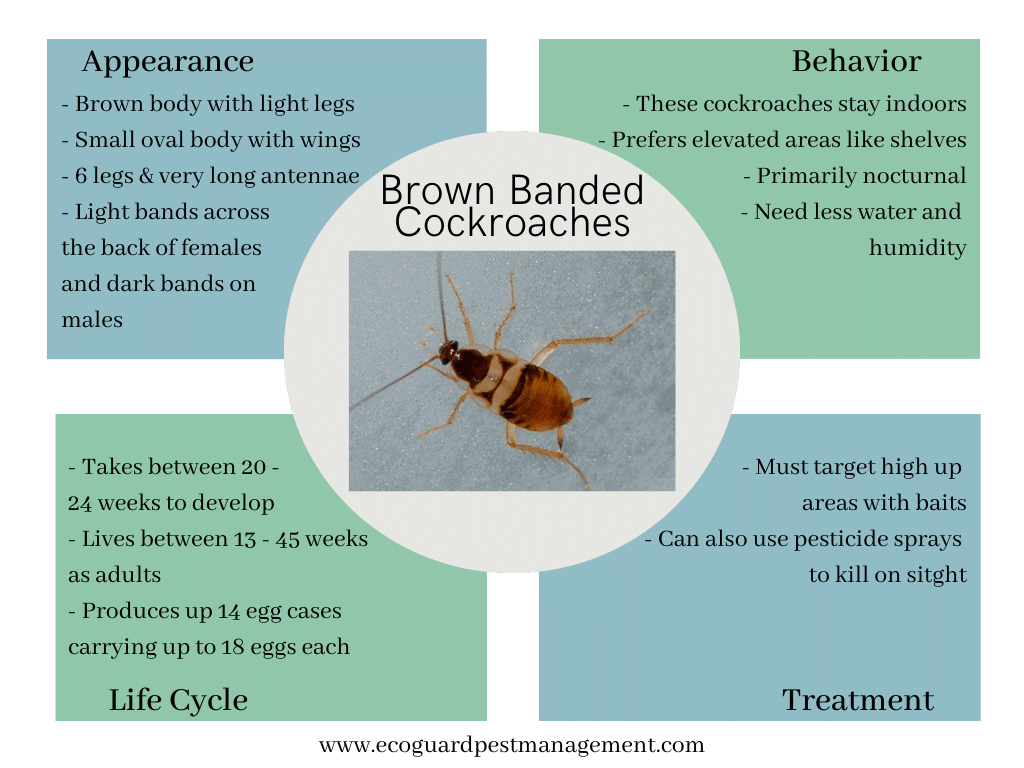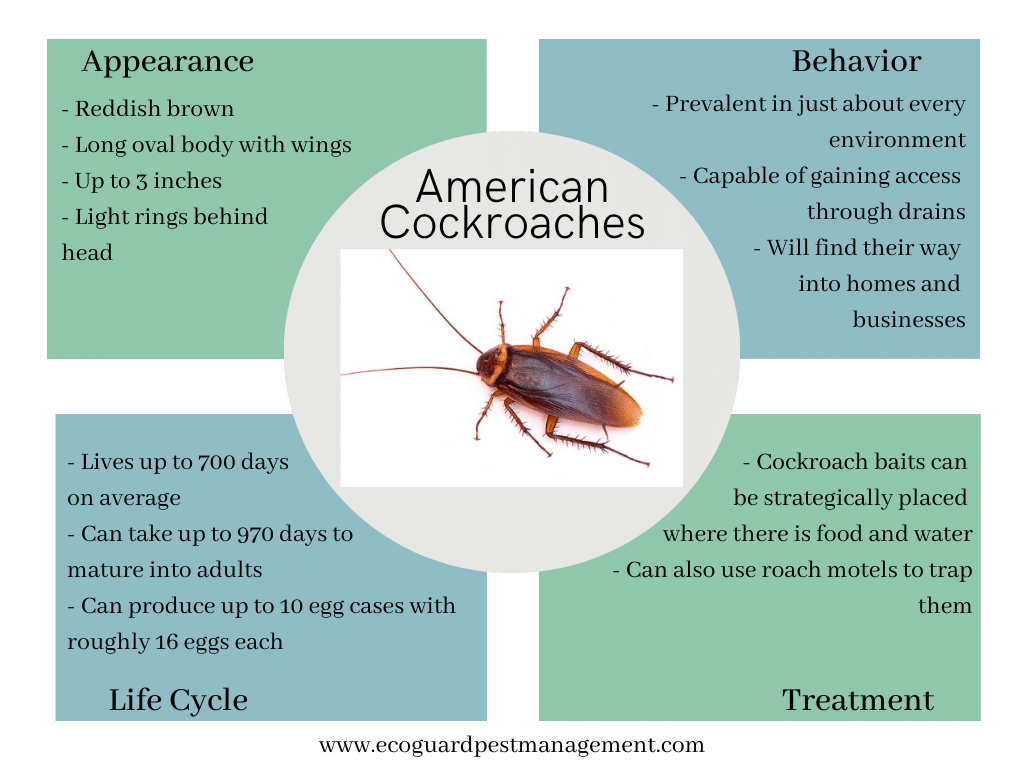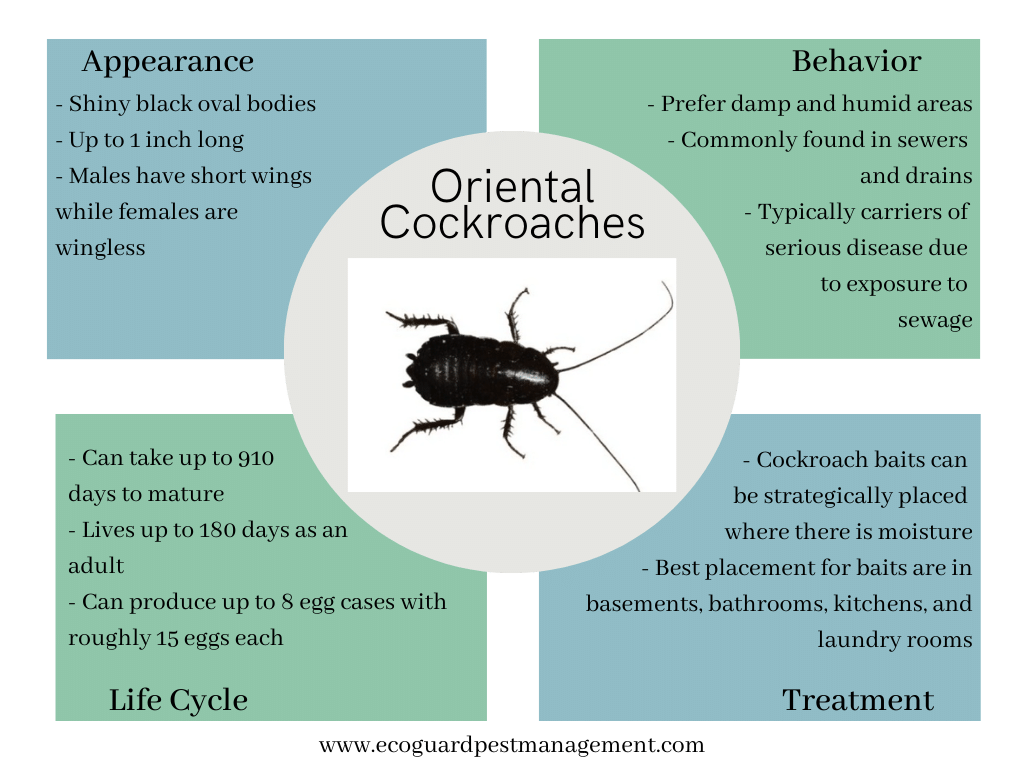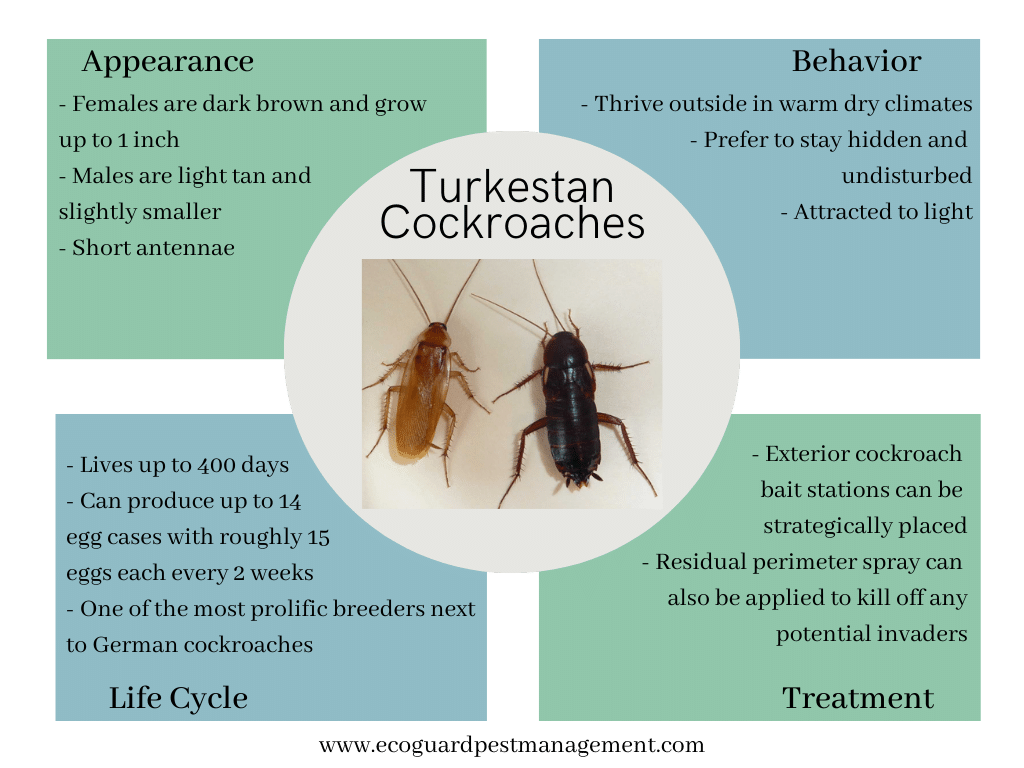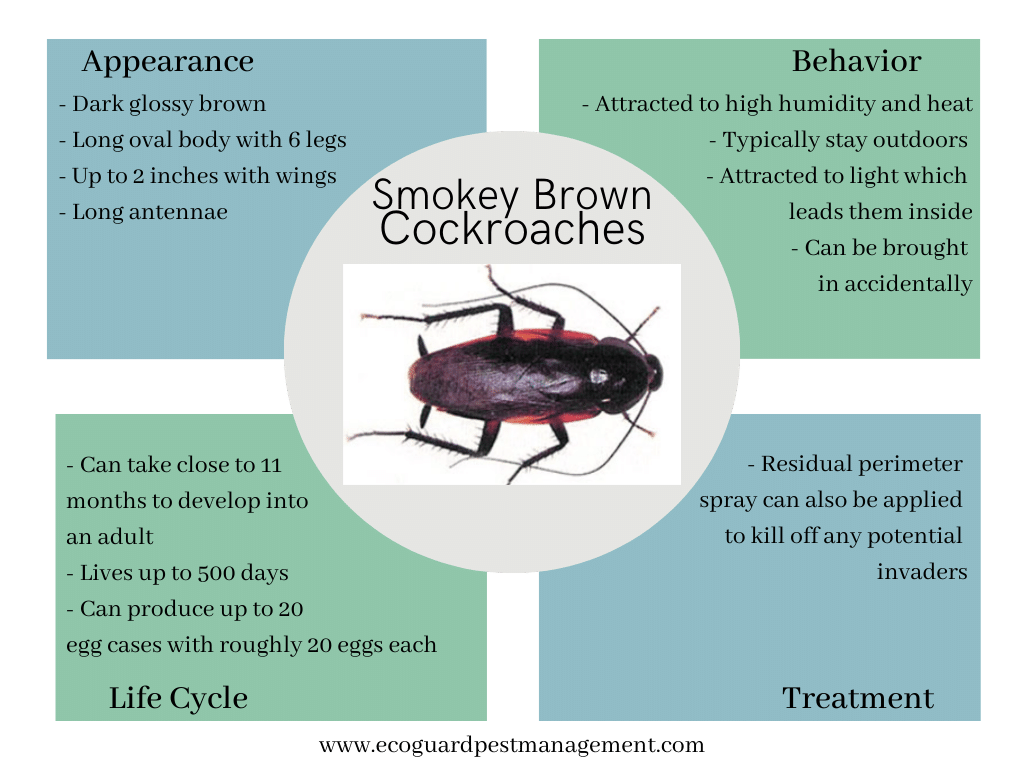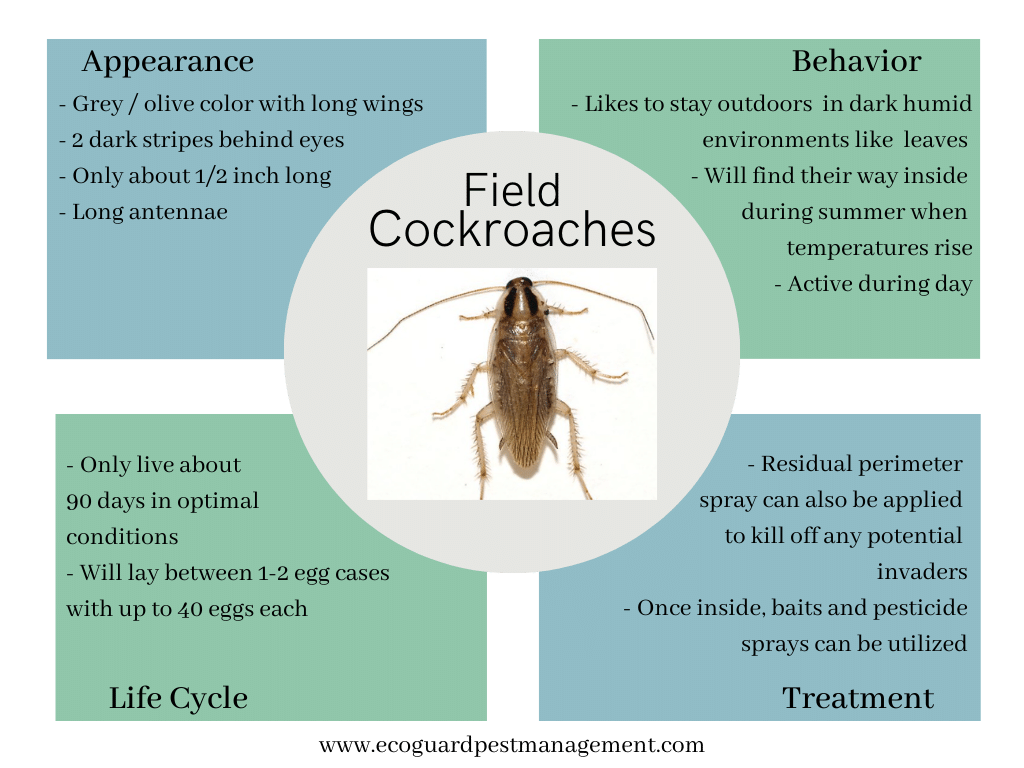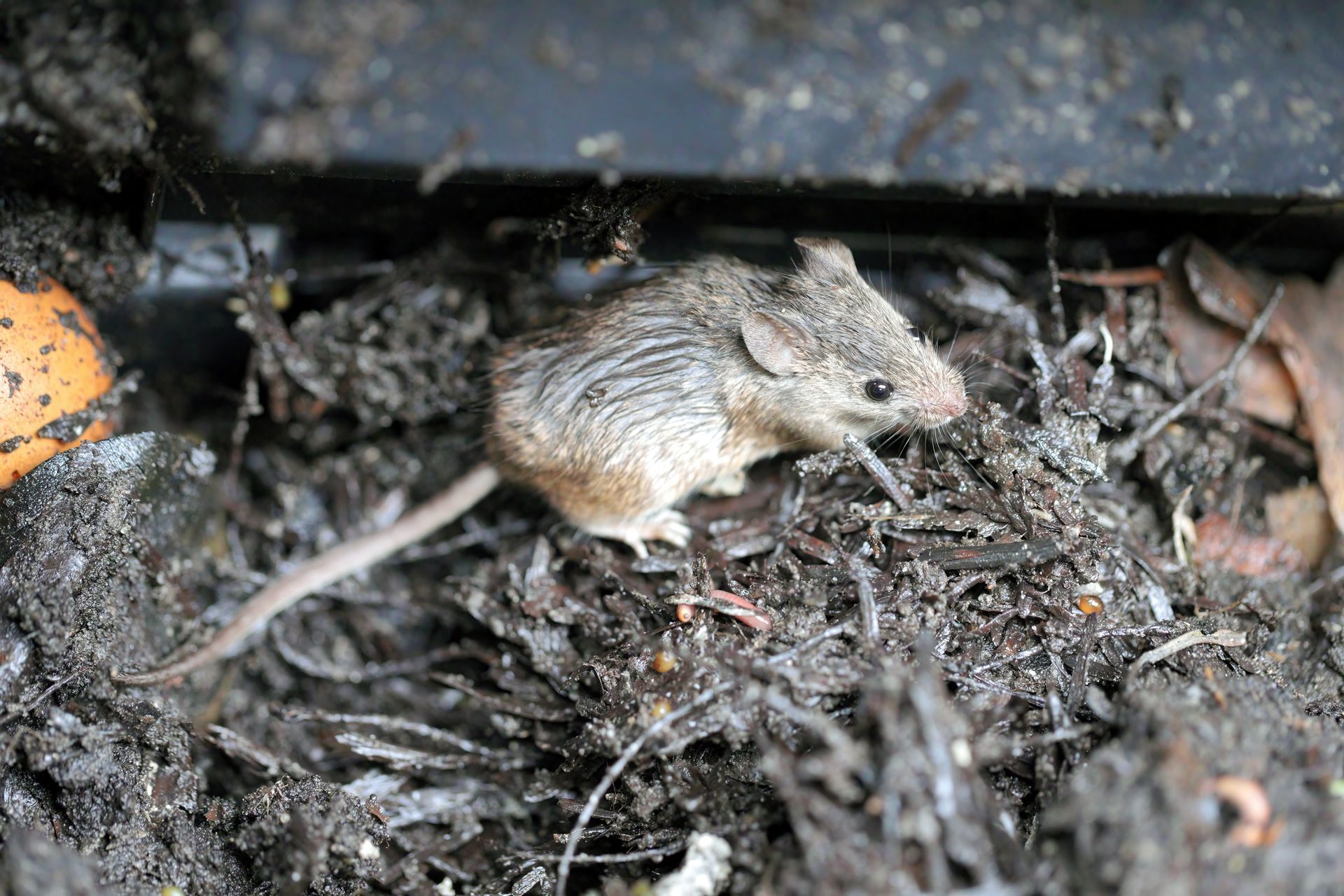Different Types of Cockroaches
Common Types of Cockroaches
2 Groups of Cockroaches
Cockroaches can be broken into 2 primary groupings: Peridomestic and domestic cockroaches. Domestic species of cockroaches are those that have adapted over human history to live alongside us in environments humans have taken over. They mostly live indoors and are found in kitchens, bathrooms, and businesses where people live and operate. Peridomestic cockroaches can live with humans but often tend to live in environments free from human interaction when possible. They are typically found outside unless temperatures or conditions become too extreme for them to survive in.
7 Common Species of North American Cockroaches
The list below makes up the most prevalent species of cockroaches found all over the US.
| Trait | German Cockroach | Brown Banded Cockroach | American Cockroach | Oriental Cockroach | Turkestan Cockroach | Smokey Brown Cockroach | Field Cockroach |
|---|---|---|---|---|---|---|---|
| Name | Blattella germanica | Supella longipalpa | Periplaneta americana | Blatta orientalis | Blatta lateralis | Periplaneta fuliginosa | Blattella Vaga |
| Group | domestic | domestic | peridomestic | peridomestic | peridomestic | peridomestic | peridomestic |
| Color | light brown | brown | reddish brown | black | rusty reddish | dark brown | greyish olive |
| Size | ~1/2 inch | ~1/2 inch | >3 inches | >1 inch | >1 inch | >2 inches | ~1/2 inch |
| Appearance | dark brown bars behind the head | light yellow bands across back | lighter brown ring behind the head | shiny black with short wings | dark body with cream color edges | dark glossy wings | 2 dark stripes on their head |
| Lifespan | >365 days | >315 days | >700 days | >200 days | >400 days | >18 months | >90 days |
| Reproduction | >40 eggs every 1 - 2 months | >18 eggs every 3 weeks | >16 eggs every 2 months | >15 eggs every 3-4 weeks | >14 eggs every 2 weeks | >20 eggs every 1 -3 weeks | >40 eggs every 4 weeks |
| Commonly Found | kitchens & pantries | kitchens & bathrooms | sewers & drains | sewers & drains | outdoors | outdoors | outdoors |
German Cockroach (Blattella germanica)
Appearance
- Light brown / tan, oval body with 6 legs & wings
- 2 side by side striped markings on back of head
- ~ ½ inch long
- Antennae much longer than body
Behavior
German cockroaches are one of the most common species found in California. Like most residential cockroach species, they will enter your home in search of shelter, food, water, and optimal breeding conditions. They are scavengers and will eat anything humans do which is why they are commonly found in kitchens and pantries. They also like warmth and humidity so it’s not unusual to find them in electronics and in the bathroom as well.
Life Cycle
German cockroaches have the fastest and most abundant reproduction cycle of all California cockroach species. In ideal conditions, they can mature into adults in roughly 60 days and then live between 20 – 30 weeks. When a female reaches maturity, she will start producing egg cases that contain up to 40 eggs every 1-2 months. These eggs will hatch into nymphs who have up to 7 moltings to complete before they reach adulthood.
How to Get Rid of Them
German cockroaches are treated so often that many have developed resistances to certain pesticides. To combat this, using several different cockroach pesticides is recommended to ensure that German cockroach populations are kept under control.
Brown Banded Cockroach (Supella longipalpa)
Appearance
- Brown oval body with 6 wings and wings
- Light color band across the back of females and nymphs
- Dark bands across the back of males
- ½ inch long
Behavior
Brown banded cockroaches find themselves at home in almost all indoor situations. They are the smallest of the residential cockroach species and are found in kitchens, pantries, bathrooms, and garages. One significant difference between brown banded cockroaches is that they prefer to be in areas that are elevated instead of being low to the ground. They are primarily nocturnal and avoid light which make them difficult to detect.
Life Cycle
Brand banded roaches develop between 20 -24 weeks and live between another 13 – 45 weeks as adults in optimal conditions. They reproduce at frightening rates. Females will produce up to 14 cases after reaching maturity with each case potentially carrying up to 18 eggs.
How to Get Rid of Them
Using cockroach baits is the best way to combat the presence of brown banded cockroaches. It is critical to strategically place the baits where they will be eaten. To ensure the baits are placed properly, they should be placed on shelves in cupboards and bookcases. Setting the baits in elevated place where brown banded cockroaches are most likely to be is the best way to get rid of them.
American Cockroach (Periplaneta americana)
Appearance
- Reddish brown oval bodies with 6 legs & wings
- Up to 3 inches; Largest household cockroach
- 2 lighter colored rings behind its head
Behavior
American cockroaches prefer to live outdoors but are so prevalent that they are now commonly found inside as well. They have become the dominant cockroach species in American sewers, and they will follow drains into homes in search of food and shelter. It’s also pretty common to find these bugs hitchhiking to new territory. They are common in restaurants, grocery stores, commercial food processing plants so they manage to get into homes via hitchhiking. No matter how the American cockroach finds its way into your home, it will likely find the resources it needs to proliferate. American cockroaches secrete and excrete allergens that can cause significant reactions and asthma attacks.
Life Cycle
American cockroaches have the longest life span, living on average 700 days and as long as 1,370 days in optimal conditions. Of that time, up to 970 days of that is spent developing into adults. Females produce about 10 egg cases with about 16 eggs each in their lifetime. Once nymphs hatch, they will molt up to 13 times.
How to Get Rid of Them
Baits and roach motels are extremely effective against American cockroaches. The bait stations and roach motels should be set in areas where American cockroaches are most likely to be. Place the traps in kitchen drawers, beside appliances like ovens and refrigerators, and under the sink.
Oriental Cockroach (Blatta orientalis)
Appearance
- Shiny and black oval bodies with 6 legs
- 1 inch long
- Males have short wings exposing their bodies
- Females don’t have wings at all
Behavior
Oriental cockroaches are often referred to as “water bugs” because they prefer to be close to areas that are damp and humid. They are often found in bathrooms around drains, pipes, and under sinks. These are also the species that are commonly found in exposed sewers and storm drains. All cockroaches can potentially harbor disease but the oriental cockroaches’ preference for environments conducive to the growth of pathogens exposes them to serious disease and bacteria. In addition to already being exposed to sewage, oriental cockroaches also give off a naturally musty odor.
Life Cycle
Oriental cockroaches can reach adulthood after 6-10 stages of nymph growth which can take between 24 – 130 weeks. After reaching maturity, females will produce egg cases that hold around 15 eggs each. This occurs approximately 8 times during the lifespan of a female oriental cockroach. Oriental cockroaches will typically survive for another 6 months after reaching adulthood.
How to Get Rid of Them
Cockroach baits are effective at getting rid of oriental cockroaches. Since oriental cockroaches like humid areas, these baits should be placed where there is a lot of moisture. Be sure to place the cockroach baits under sinks and in areas like basements, bathrooms, kitchens, and laundry rooms.
Turkestan Cockroach (Blatta Lateralis)
Appearance
- Females are dark brown / black and 1 inch long
- Males are smaller and rusty colored with light wings
- Oval bodies with 6 legs and wings
- Cream colored edges on the body
Behavior
Turkestan roaches thrive outside and prefer warm dry climates. They generally stay outside and will build nests in undisturbed parts of your yard. They are attracted to light however, which will draw them indoors in the evenings.
Life Cycle
A female will produce a case with 14 eggs at a time and will produce up to 350 eggs over her lifetime. Mature Turkestan cockroaches are known to live for up to 13 months meaning that in optimal conditions they produce an oothecae every 2 weeks. Turkestan cockroaches are competing with German cockroaches for dominant species and are edging out other outdoor cockroach populations with their rate of reproduction.
How to Get Rid of Them
Leaving cockroach baits outside and spraying a perimeter spray are a great way to exterminate Turkestan cockroaches. These cockroaches prefer to stay outdoors so the baits will attract them and kill them. However, if the external conditions drive cockroaches inside, the perimeter spray will do an effective job of killing off any invaders.
Smoky Brown Cockroach (Periplaneta fuliginosa)
Appearance
- Dark glossy brown oval shaped body with 6 legs
- Up to 1 ½ inches
- Dark wings that extend beyond the body
Behavior
Smoky brown cockroaches are attracted to areas with high humidity and heat. They prefer outdoors but will find their way in when conditions outside become difficult to survive or if they find an open window that will give them access to a light source. They are also brought in on accident frequently as they will live in firewood and boxes that were kept in storage.
Life Cycle
Smoky brown cockroaches can take up to 320 days to reach maturity. Once they reach maturity, they only live for another 6 months on average. In that time, females will produce between 10-30 egg cases with 20 eggs in each case.
How to Get Rid of Them
Smokey brown cockroaches are outdoor cockroaches so a simple perimeter spray should do a good job of keeping these bugs out. If temperatures or conditions drive these cockroaches in, they will cross that perimeter spray and become infected before dying off.
Field Cockroach (Blattella Vaga)
Appearance
- Greyish to olive color oval bodies with 6 legs and wings
- 2 dark stripes on head
- ½ inch long
Behavior
Field cockroaches prefer to stay outdoors unless the environment becomes to dry and hot for it to survive. In the peak of summer, field cockroaches might migrate inside to escape hot temperatures. Otherwise, they will be found in piles of leaves and under shrubbery. These cockroaches are not deterred by light and are active all day long.
Life Cycle
Field cockroaches have one of the shorter life spans due to them living for about 90 days. In that time, they produce 1-2 egg cases with up to 40 eggs each. They are short lived but they are capable of rapid expansion in a relatively short period.
How to Get Rid of Them
Field cockroaches tend to stay outside so leaving baits and applying a perimeter spray should do the job to keep these bugs under control. Be sure to spray a residual pesticide application anywhere they are seen as well as along the perimeter of a home to keep them out.
Contact EcoGuard Pest Management if You Are Dealing with Cockroaches
If you are starting to see signs of cockroaches, it likely means that there is a larger cockroach presence that hasn’t been discovered yet. Be sure to call EcoGuard Pest Management today to schedule a cockroach inspection. Our team of qualified cockroach exterminators will get rid of your cockroaches immediately using an integrated pest management approach. This ensures that cockroaches are treated for and prevented from returning. Call today to schedule an appointment!



